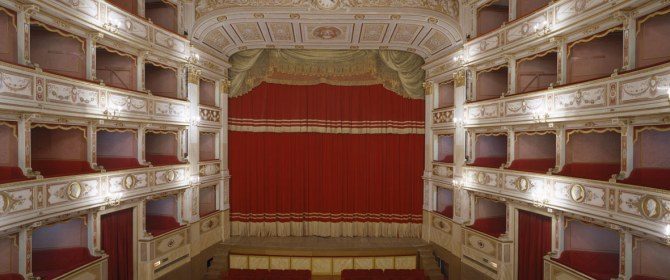Il Teatro Comunale di Todi venne progettato dall’architetto Carlo Gatteschi ed inaugurato nel 1876 con l’opera di Giuseppe Verdi “Un Ballo in Maschera”. Il Teatro al suo interno si presenta signorile e curato in ogni suo particolare anche grazie al grande sipario che raffigura la “Visita a Todi di Ludovico Ariosto” dipinto dal pittore perugino Annibale Brugnoli.
Il teatro dispone di 499 posti a sedere; attualmente ospita la stagione teatrale di Todi.
The Municipal Theater of Todi was designed by architect Charles Gatteschi and inauguratedin 1876 with the work of Giuseppe Verdi’s “Un Ballo in Maschera.” The Theatre to its interior is elegant and accurate in every particular thanks to the great curtain thatdepicts the “Visit Todi Ludovico Ariosto” painted by Annibale Brugnoli.
The theater has 499 seats; now houses the theater season of Todi.
The Municipal Theater of Todi was designed by architect Charles Gatteschi and inauguratedin 1876 with the work of Giuseppe Verdi’s “Un Ballo in Maschera.” The Theatre to its interior is elegant and accurate in every particular thanks to the great curtain thatdepicts the “Visit Todi Ludovico Ariosto” painted by Annibale Brugnoli.
The theater has 499 seats; now houses the theater season of Todi.
The Municipal Theater of Todi was designed by architect Charles Gatteschi and inauguratedin 1876 with the work of Giuseppe Verdi’s “Un Ballo in Maschera.” The Theatre to its interior is elegant and accurate in every particular thanks to the great curtain thatdepicts the “Visit Todi Ludovico Ariosto” painted by Annibale Brugnoli.
The theater has 499 seats; now houses the theater season of Todi.
The Municipal Theater of Todi was designed by architect Charles Gatteschi and inauguratedin 1876 with the work of Giuseppe Verdi’s “Un Ballo in Maschera.” The Theatre to its interior is elegant and accurate in every particular thanks to the great curtain thatdepicts the “Visit Todi Ludovico Ariosto” painted by Annibale Brugnoli.
The theater has 499 seats; now houses the theater season of Todi.


Comment (0)